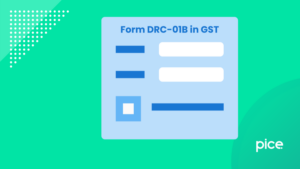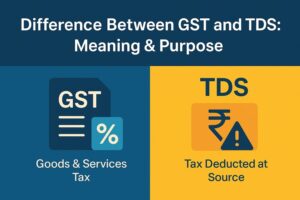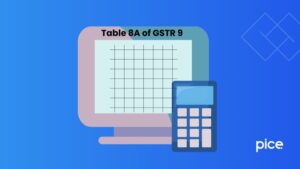E-commerce Operator Under GST
- 10 Jan 25
- 11 mins

E-commerce Operator Under GST
Key Takeaways
- E-commerce operators under Section 9(5) pay GST on specified services without TCS.
- Section 52 mandates ECOs to collect TCS on taxable supplies excluding specified services.
- ECOs require GST and TCS registration based on their operational model.
- E-invoicing compliance is essential for ECOs and suppliers exceeding turnover limits.
- New GSTR tables simplify ITC claims and reporting for ECO-facilitated transactions.
An e-commerce operator under GST (Goods and Services Tax) might act as an electronic commerce platform or supplier of goods and services. GST imposition on e-commerce operators is regulated under Section 9(5) and Section 52 of the CGST Act (Central Goods and Services Tax Act) based on the function of the e-commerce operator. Learn in detail about GST applicability on e-commerce operators here.
Statutory Interpretation and Legal Maxim
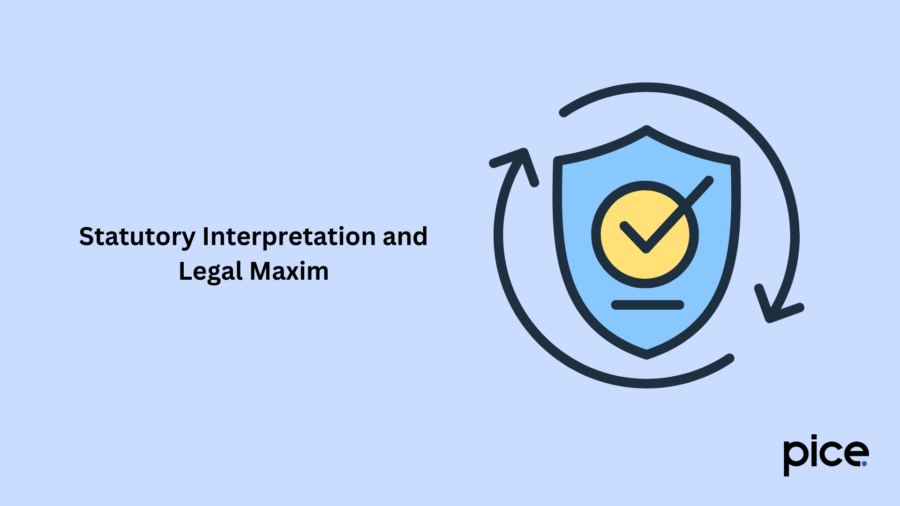
Under GST regulations, an electronic commerce operator (ECO) is a person owning, operating or managing a digital platform or electronic network facility for e-commerce (electronic commerce). Under the regulations of foreign exchange management legislation, the electronic commerce landscape is segregated into the following models:
1. Inventory-Based Model
In this model, the e-commerce operator owns the inventory of goods and services to sell them directly to customers. This model legally mandates e-commerce operators to collect and remit applicable GST in taxable supplies.
2. Marketplace Model
In this model, the e-commerce operator acts as the intermediary facilitating transactional interactions between purchasers and online sellers. This model necessitates e-commerce operators to collect TCS (Tax Collection at Source) on taxable supplies undertaken using their e-commerce platform. In addition, e-commerce operators levy GST on platform-related services that they provide directly to merchants.
Analogy Between Both the Pillars
The table below illustrates the analogy between the two pillars of e-commerce transactions under GST regulations:
| Parameter | Pillar 1: Section 9(5) of the CGST Act | Pillar 2: Section 52 of the CGST Act |
| Coverage | It covers 'specified services' that an e-commerce operator (ECO) supplies under GST, including restaurant services and cloud kitchens, accommodation in hotels and guest houses, housekeeping services and passenger transportation services using motor vehicles. | It includes all taxable supplies or services and goods undertaken by an e-commerce operator, excluding ‘specified services’. The e-commerce operator has to collect the GST on the actual supplier’s behalf. |
| Collection of TCS/Tax Liability | The e-commerce operator is liable to pay GST and TCS does not apply. | An e-commerce operator has to collect TCS on the net taxable supplies value. The applicable GST rate for TCS is 0.25% + 0.25% (CGST and SGST) or 0.5% IGST presently. |
| Registration Requirements for ECO | ECO does not need TCS registrations; however, it needs regular registration to facilitate specified services supply, irrespective of whether it is a representative or has a physical presence in India. In other words, they do not need tax at source registration. | ECO needs TCS registration to facilitate goods and services supply (excluding specified services) in the state or union territory where the supplier is registered. Even if the ECO does not have a place of business or establishment in each Indian union territory or state, it requires TCS registration. An ECO might require separate GST registrations to operate in different states or union territories for inter-state supplies. |
| Registration Requirements for Suppliers | A service provider can comply with the threshold exemption limit for GST registration. | While suppliers of services can adhere to the threshold exemption under GST for registration, suppliers of goods need mandatory GST registration. |
| Returns and Reporting | Both the ECO and the supplier (registered person) need to provide details of supplies in GSTR-1 and GSTR-3B. | The e-commerce operator has to report supplies in addition to TCS in compliance with Form GSTR-8 in the monthly filing. Suppliers have to report these details in GSTR-1 and GSTR-3B. Suppliers can raise TCS claims in their electronic cash ledger on successful validation. |
The Government of India has further brought forth certain changes in the newly introduced tables for e-commerce transaction reporting, which will likely simplify the compliance and reconciliation processes.
Government-Introduced New Tables for E-commerce Operators
Here are the changes that the government introduced:
1. Auto-Population of E-invoice
Based on the GSTN advisory for newly introduced tables, the GSTN issued on 15th January 2024 that the Table-15 will not auto-populate e-invoice. However, in accordance with the existing functionality, e-invoices reported for supplies under Section 9(5) will auto-populate in GSTR-1. E-commerce operators can check and add supply-related records under Section 9 (5) in Table 15.
2. New Table Addition in GSTR 2B: 'ECO-Documents'
Taxpayers enjoy a facility to pass ITC (Input Tax Credit) to registered recipients who receive supplies under Section 9(5) through e-commerce operators. There will be a new table addition in GSTR-2B termed 'ECO Documents' under the 'All Other ITC' section.
This table allows registered recipients to view the document details related to the supplies undertaken using e-commerce operators. The e-commerce operator is liable to pay tax on these supplies under Section 9(5) of the Act. This new ECO-Documents table of GSTR-2B will auto-populate the values from Table 15 of GSTR-1.
Crossing the Industry Complexities

The e-commerce industry is constantly confronting several challenges due to the rapidly changing technological landscape and reduced margins. Further, ECOs often provide incentives to their customers in the form of reward points and cashback. This results in complicated valuation and reporting mechanisms under the GST norms.
Consider the example below, wherein an e-commerce platform supply has the following specifications:
| Particulars | Specified Services Under Section 9(5) | Other Taxable Supplies |
| Taxable Value of Supply | ₹1,000 | ₹1,000 |
| Discount offered to a customer by an e-commerce operator while supplying goods | ₹100 | ₹100 |
| The amount which the e-commerce operator has to collect from the customer | ₹900 | ₹900 |
Considering the scenarios mentioned above, there can be two ambiguities arising as follows:
- Ambiguity about the taxable value and the reporting mechanism under GST for the supply.
- Whether to consider the discounts that the e-commerce operator offered in TCS calculation.
To resolve this ambiguity, the e-commerce industry considers the value collectable from the customer as the taxable value for the TCS process and reporting.
In addition, the Indian e-commerce market faced ambiguities pertaining to IT infrastructure or platform services. Addressing this ambiguity in a particular case, the Karnataka Appellate Authority for Advance Ruling (AAAR) stated that cab booking services are a supply of services that the e-commerce operator navigates using its IT platform. In other words, these are digital services. As a result, ECO is liable to discharge the tax liability.
In another instance, the AAAR found that the applicant developed the computer application to ensure connectivity between drivers and passengers. However, it did not control the actual provision of services. As a result, the applicant was not liable for tax liability discharge on the actual supplier's behalf, despite it being categorised as an e-commerce operator.
Additional challenges that the e-commerce industry faces under the GST system include compliance and reconciliation, TCS implications on cross-border e-commerce sales (or other cross-border e-commerce transactions), adjustment of TCS for returned goods to the e-commerce operator or the actual supplier and issuance of GST documents for the shipment of the goods returned.
E-invoicing for E-Commerce Operators
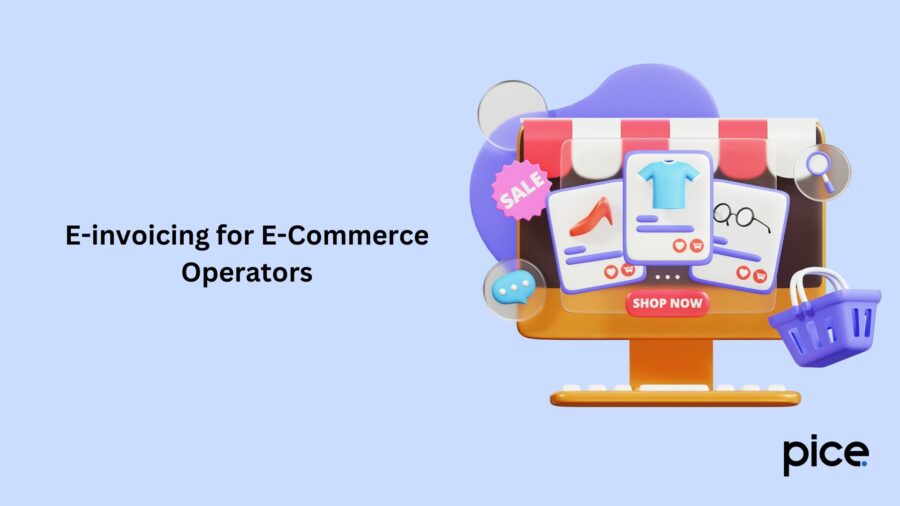
Under the GST regulations, the supplier is liable to collect GST from the recipient and pay the same to the government. However, e-commerce company services fall under the Reverse Charge Mechanism (RCM) of GST. In RCM, the recipient bears the tax liability instead of the supplier.
Supplier’s aggregate turnover plays an important role for e-commerce operators as the e-commerce transactions are undertaken by the supplier. The e-invoicing turnover limit under the e-invoicing mandate determines if e-invoice generation is necessary for suppliers.
Either the supplier or the e-commerce operator on behalf of the supplier generates the e-invoice. Nevertheless, the process followed by the criteria to assign Invoice Reference Number (IRN) to e-invoices under the GST system remains unchanged.
Consider the following examples to understand how e-invoicing works under GST:
Scenario 1:
For instance, you purchased a Dell laptop from Amazon. Amazon will provide you with an invoice for your purchase. However, IRN and e-invoice generation will be between Amazon and Dell. Thus, Dell is the supplier wherein Amazon’s GSTIN will be considered as the e-commerce GSTIN in e-invoice registration.
On the flip side, if the e-commerce platform acts as a seller, it will be treated as a supplier instead of an e-commerce platform. In such a scenario, the annual turnover of the organisation plays an integral role. In case, it is below the e-invoice turnover criteria, it has to comply with e-invoicing rules under GST.
Scenario 2:
Suppose a supplier sells its products using an e-commerce platform. In such a case, the e-commerce supplier will be considered as a supplier of services. Notably, the annual turnover of the e-commerce platform plays an important role in this scenario as well.
If the annual turnover of the e-commerce organisation exceeds ₹10 crore, it has to register the e-invoice on the ‘Invoice Registration portal’ to generate IRN under GST. However, if the e-commerce platform generates the e-invoice, it will reflect on the seller’s IRP.
Here is the applicable scope if both the supplier and the e-commerce platform generate IRN:
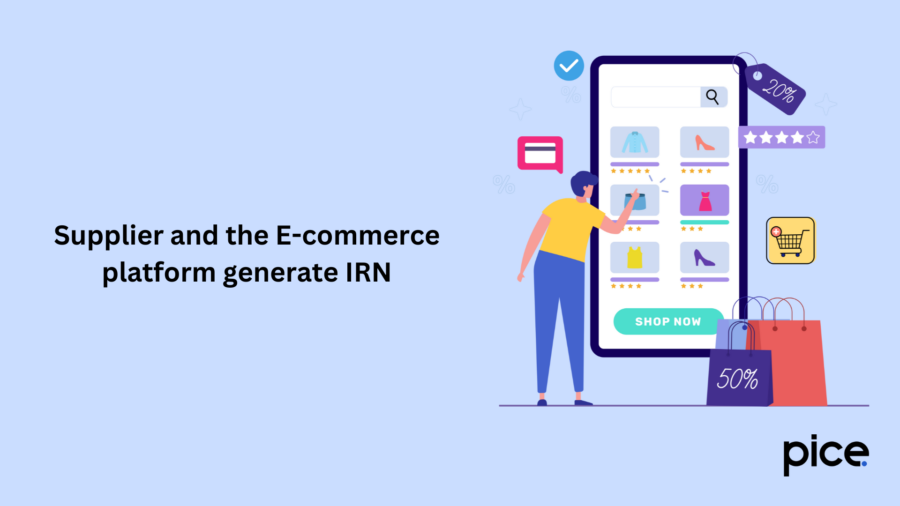
| Accessible to | e-commerce Operator | Supplier |
| E-commerce Operator generates IRN | Yes | Yes |
| Supplier generates IRN | No | Yes |
| E-commerce operator cancels IRN | Yes | Yes |
| Supplier cancels IRN | No | Yes |
| EWB generation for e-commerce operator-generated IRN | Yes | Yes |
| EWB generation for supplier-generated IRN | Yes | Yes |
If you are a business entity, you can consider using specific tools to generate e-invoices and IRNs. These tools enable you to generate e-invoices and e-way bills using a single platform. You can further ensure error-proof bulk upload with e-invoice compliance.
If you belong to any of the following categories of businesses that can use the specially designed tools to generate e-invoices and IRNs:
- If you are a small business owner, such as MSME/SME (Micro Small and Medium Enterprises/Small and Medium Enterprises)
- In case you are a large business owner
- If you are a solution provider
Conclusion
Under Section 9(5) of the CGST Act, an e-commerce operator under GST has to pay GST to the government after collecting the same from the customer. However, under this section, TCS is not applicable.
On the flip side, under Section 52 of the CGST Act, the e-commerce operator has to collect TCS on the net value of supply. The applicable IGST rate for TCS is 0.5%, while the CGST and SGST rates are 0.25% each. Based on your function, you need to adhere to GST laws as an e-commerce operator.
💡If you want to streamline your payment and make GST payments, consider using the PICE App. Explore the PICE App today and take your business to new heights.
 By
By 






